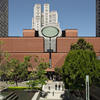More about Super Nova
- All
- Info
- Shop

Contributor
Are you trippin' yet? Seems like Takashi Murakami was when he dreamt up Super Nova.
This sizable seven-panel painting highlights Murakami’s quintessential aesthetic in which he revamps objects from the mundane everyday and stylizes them with a kitsch cuteness that's revered in Japanese culture today. Greatly influenced by manga and anime, Murakami translates their flat, 2-D imagery to create his out out-there style. This aesthetic, which he coined as “Superflat”, attempts to show no brushstrokes or sense of perspective and depth. Fortunately for Murakami, the painstaking patience that is required to achieve such flatness is unbeknownst to him, due to the fact that he never touches his art but rather hires technicians to create his paintings for him. Cushy.
The repeated mushroom motif seems hallucinogenic, magical, atomic. Prior to becoming an artist, Murakami was heavily involved in the antinuclear movement and saw in art the potential for social commentary and change. In fact, Murakami created his Superflat stylization as a commentary of the bombing of Hiroshima and Nagasaki in 1945, when huge cities were literally flattened to the ground. While this painting has clear references to Japan’s turbulent history, with monstrous mushies made human by radiation, the viewer is still left with a sense of playful curiosity. What will these funky fungi get up to next?













